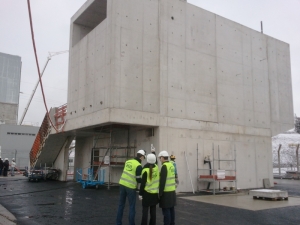EDF's plans to improve emergency cooling systems and to reinforce the basemat of the reactor at unit 1 of the Fessenheim plant are "satisfactory" to meet requirements for its continued operation, the French nuclear regulator said.
 |
| ASN inspectors at Fessenheim (Image: ASN) |
The French Nuclear Safety Authority (Autorité De Sûreté Nucléaire, ASN) ruled in July 2011 that the country's oldest operating nuclear power reactor, Fessenheim 1, can be operated for ten more years provided it complies with requirements. Chief amongst these are a requirement to strengthen the unit's concrete basemat, which must be completed before 30 June 2013, and a requirement to make improvements to systems for removing residual power in the case of a loss of cooling function, to be completed before the end of 2012.
Following a site inspection on 11 December, the ASN said that progress on the additional cooling capabilities is "satisfactory" and that all the necessary documentation for the use of the system should be in place by the end of the year, when the system should be operational.
The ASN has also reviewed documentation submitted by plant operator EDF on its plans to reinforce the basemat of Fessenheim 1. The 1.5-metre thick concrete basemat must be strengthened to make it more resistant to corium - a mixture of molten cladding, fuel, and structural steel formed in the event of a serious accident involving the melting of fuel in the reactor.
EDF plans to thicken the basemat by 50cm, as well as to increase its surface area by allowing corium to flow from the reactor pit through a purpose-built channel into an adjacent room, the floor of which will also be thickened. EDF developed its plan based on an analysis by the Institute for Radiation Protection and Nuclear Safety (IRSN).
The ASN has now approved these plans, but requested that EDF submit details of the proposed radiation protection for workers performing the work. In addition, it noted that the IRSN had warned that if water were to be present in the reactor pit, the spread of corium would be disrupted. The ASN therefore recommended that EDF takes the necessary steps to ensure water cannot enter this area. It also asked EDF to pay particular attention to the chemical composition of the concrete that will be used for thickening the basemat.
Uncertain future
President Francois Hollande, who was elected in May on a promise to reduce the share of nuclear energy in the mix to about 50% by 2025, has already decided that Fessenheim 1 should close in 2016, effectively over-ruling the prior decision by the ASN. A national debate is underway to discuss France's 'energy transition', the results of which will be used in formulating a new energy policy bill in mid-2013. However, until confirmation of that 2016 shutdown date, the Fessenheim plant must still comply with the safety requirements set by the regulator for continued operation.
The first of Fessenheim's two 880 MWe pressurized water reactors entered commercial service in 1977, followed several months later by the second unit in early 1978. The third ten-yearly inspection of Fessenheim 2 was completed in March 2012. The ASN said that it would be in a position in the first half of 2013 to rule on the continued operation of that unit.
Researched and written
by World Nuclear News





_63865.jpg)
_18570.jpg)
_16159.jpg)





